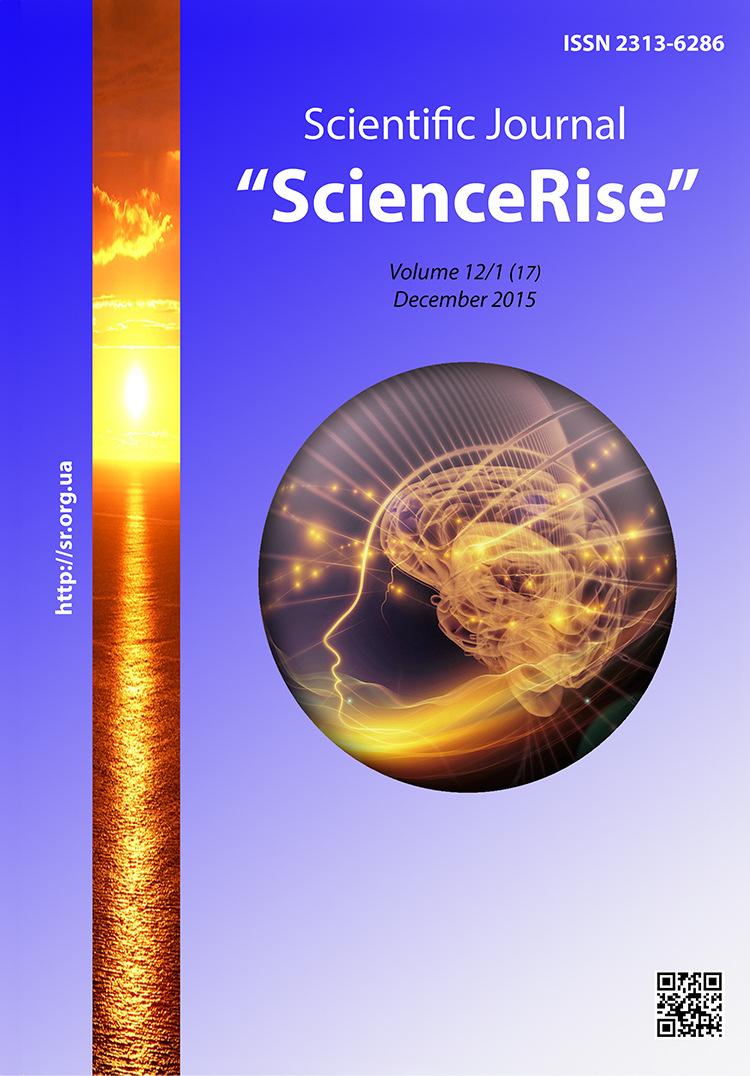Аналіз методів дослідження складу видихуваного повітря
DOI :
https://doi.org/10.15587/2313-8416.2015.56679Mots-clés :
газовий аналіз, молекули-біомаркери, маркерні гази, видихуване повітря, діагностика, методи, сенсориRésumé
В статті розглянуті особливості процесу детектування слідів газоподібних молекул у видихуваному повітрі людини. Проведена класифікація основних фізико-хімічних методів аналізу молекул-біомаркерів у видихуваному повітрі, наведені їх переваги та недоліки. Проаналізовані методи низькочутливого газового аналізу та визначено потенційний метод для розробки портативного газоаналізатора видихуваного повітря
Références
Pauling, L., Robinson, A. B., Teranishi, R., Cary, P. (1971). Quantitative Analysis of Urine Vapor and Breath by Gas-Liquid Partition Chromatography. Proceedings of the National Academy of Sciences, 68 (10), 2374–2376. doi: 10.1073/pnas.68.10.2374
Stepanov, E. (2009). Diodnaja lazernaja spektroskopija i analiz molekul-biomarkerov. Moscow: Fizmatlit, 416.
Phillips, M. (1992). Breath Tests in Medicine. Scientific American, 267 (1), 74–79. doi: 10.1038/scientificamerican0792-74
Phillips, M., Herrera, J., Krishnan, S., Zain, M., Greenberg, J., Cataneo, R. N. (1999). Variation in volatile organic compounds in the breath of normal humans. Journal of Chromatography B: Biomedical Sciences and Applications, 729 (1-2), 75–88. doi: 10.1016/s0378-4347(99)00127-9
Le Marchand, L., Wilkens, L. R., Harwood, P., Cooney, R. V. (1992). Use of breath hydrogen and methane as markers of colonic fermentation in epidemiologic studies: circadian patterns of excretion. Environmental Health Perspectives, 98, 199–202. doi: 10.1289/ehp.9298199
Hamilton, L. (1998). Breath Tests and Gastroenterology. Milwaukee: QuinTron Instrument Co, 123.
Coburn, R. F., Williams, W. J., Kahn, S. B. (1966). Endogenous carbon monoxide production in patients with hemolytic anemia. Journal of Clinical Investigation, 45 (4), 460–468. doi: 10.1172/jci105360
Tiunov, A., Kustov, V. (1980). Produkty metabolizma pri radiacinnom porazhenii. Moskva: Atomizdat, 104.
Gustafsson, L. E., Leone, A. M., Persson, M. G., Wiklund, N. P., Moncada, S. (1991). Endogenous nitric oxide is present in the exhaled air of rabbits, guinea pigs and humans. Biochemical and Biophysical Research Communications, 181 (2), 852–857. doi: 10.1016/0006-291x(91)91268-h
Alving, K., Weitzberg, E., Lundberg, J. (1993). Increased amount of nitric oxide in exhaled air of asthmatics. Eur. Respir. J., 6, 1368–1370.
Vaks, V., Domradcheva, E., Sobakinskaja, E., Chernjaeva, M. (2014). Analiz vydyhaemogo vozduha: fizicheskie metody, pribory i medicinskaja diagnostika. Uspehi Fizicheskih Nauk, 184, 739–758.
Stepanov, E. (2005). Metody vysokochuvstvitel'nogo gazovogo analiza molekul-biomarkerov v issledovanija vydyhaemogo vozduha. Trudy Instituta Obshhej Fiziki im. A. M. Prohorova, 67, 5–47.
Vreman, H., Stevenson, D. (1994). Semiportable electrochemical instrument for determining carbon monoxide in breath. Clin. Chem., 10, 1927–1933.
Pelli, M. A., Trovarelli, G., Capodicasa, E., De Medio, G. E., Bassotti, G. (1999). Breath alkanes determination in ulcerative colitis and Crohnʼs disease. Diseases of the Colon & Rectum, 42 (1), 71–76. doi: 10.1007/bf02235186
Hmel'nickij, R., Brodskij, E. (1984). Hromato-mass-spektrometrija. Moskva: Himija, 216.
Esterbauer, H. (1996). Estimation of peroxidative damage. A critical review. Pathol Biol., 44, 25.
Zemskov, V., Khrapach, V., Liashenko, V. (1992). Value of exhaled air acetone level in assessing the impairement of secretory pancreatic function in acute destructive pancreatitis. Klin Khir., 11, 9–11.
Tangerman, A., Winkel, E. G., de Laat, L., van Oijen, A. H., de Boer, W. A. (2012). Halitosis and Helicobacter pylori infection. Journal of Breath Research, 6 (1), 017102. doi: 10.1088/1752-7155/6/1/017102
Bajerman, K. (1987). Opredelenie sledovyh kolichestv organicheskih veshhestv. Moscow: Mir, 429.
Španěl, P., Smith, D. (2007). Selected ion flow tube mass spectrometry for on-line trace gas analysis in biology and medicine. European Journal of Mass Spectrometry, 13 (1), 77–82. doi: 10.1255/ejms.843
Boshier, P. R., Cushnir, J. R., Mistry, V., Knaggs, A., Španěl, P., Smith, D., Hanna, G. B. (2011). On-line, real time monitoring of exhaled trace gases by SIFT-MS in the perioperative setting: a feasibility study. Analyst, 136 (16), 3233. doi: 10.1039/c1an15356k
Smith, D., Španěl, P. (2011). Direct, rapid quantitative analyses of BVOCs using SIFT-MS and PTR-MS obviating sample collection. TrAC Trends in Analytical Chemistry, 30 (7), 945–959. doi: 10.1016/j.trac.2011.05.001
Dummer, J. F., Storer, M. K., Hu, W.-P., Swanney, M. P., Milne, G. J., Frampton, C. M. et. al. (2010). Accurate, reproducible measurement of acetone concentration in breath using selected ion flow tube-mass spectrometry. Journal of Breath Research, 4 (4), 046001. doi: 10.1088/1752-7155/4/4/046001
Vaks, V., Domracheva, E., Maslennikova, A. (2012). Primenenie metodov i sredstv nestacionarnoj spektroskopii subTGc i TGc diapazonov chastot dlja neinvazivnoj medicinskoj diagnostiki. Opticheskij Zhurnal, 79 (2), 9.
Vaks, V., Domracheva, E., Sobakinskaya, E., Chernyaeva, M. (2012). Upgrading the sensitivity of spectroscopy gas analysis with application of supersonic molecular beams. Journal of Applied Physics, 111 (7), 074903. doi: 10.1063/1.3699053
Vaks, V., Balakirev, V., Panin, A. (2010). Razrabotka fizicheskih principov postroenija i realizacii spektrometra diapazona 500-700GHz so sverhprovodnikovym integral'nym priemnikom. Fizika Tverdogo Tela, 52 (11), 2100–2103.
Kucheruk, V. (1999). Analiz isnujuchyh zasobiv vymirjuvannja mehanichnyh harakterystyk elektrychnyh mashyn. Vymirjuval'na Tehnika Ta Metrologija, 54, 125–138.
Téléchargements
Publié-e
Numéro
Rubrique
Licence
(c) Tous droits réservés Артур Олександрович Запорожець, Анастасія Дмитрівна Свердлова 2015

Cette œuvre est sous licence Creative Commons Attribution 4.0 International.
Our journal abides by the Creative Commons CC BY copyright rights and permissions for open access journals.
Authors, who are published in this journal, agree to the following conditions:
1. The authors reserve the right to authorship of the work and pass the first publication right of this work to the journal under the terms of a Creative Commons CC BY, which allows others to freely distribute the published research with the obligatory reference to the authors of the original work and the first publication of the work in this journal.
2. The authors have the right to conclude separate supplement agreements that relate to non-exclusive work distribution in the form in which it has been published by the journal (for example, to upload the work to the online storage of the journal or publish it as part of a monograph), provided that the reference to the first publication of the work in this journal is included.

